Walmart Ad Types 101: How to Reach More Shoppers and Boost Sales on Walmart
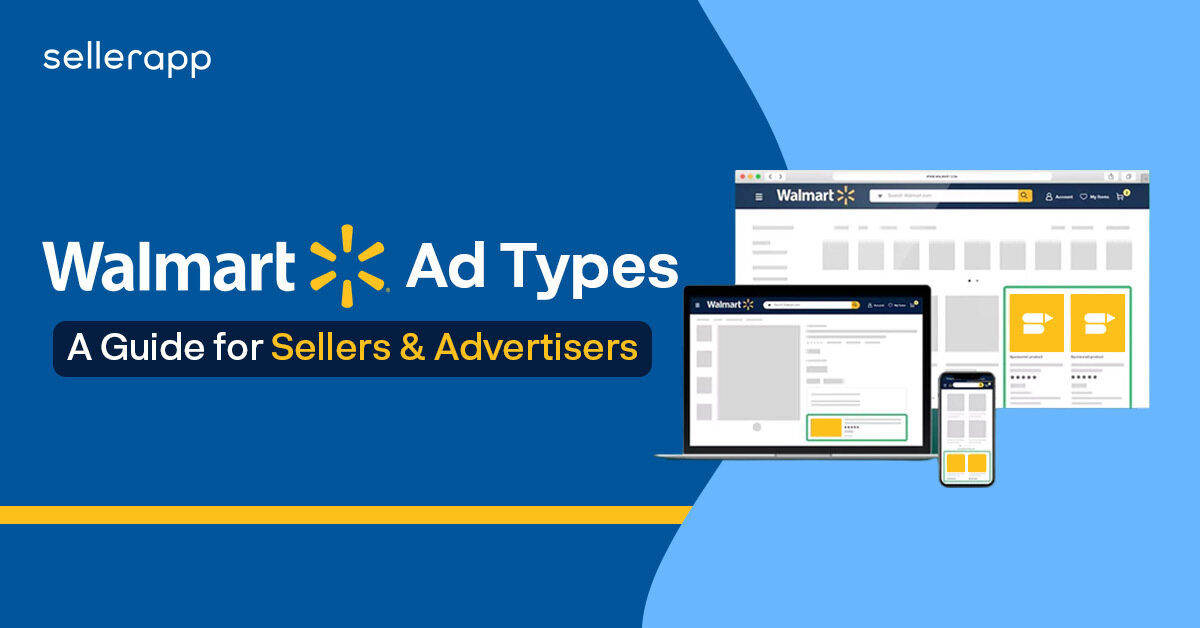
With more than 11,000 stores across 27 countries, Walmart is one of the largest retailers in the world.
Not only that, it attracts 150 million customers every week, both online and offline, and 90% of American shoppers buy at Walmart.
That’s a lot of potential buyers for your brand!
But how can you reach them effectively?
The answer is Walmart advertising.
Walmart offers various advertising solutions for brands that want to showcase their products to its massive audience.
However, not all Walmart ads are created equal.
Depending on your objectives, budget, and target market, some types of Walmart ads may work better than others.
In this blog post, we will guide you through the different types of Walmart ads and how they can help you boost your sales.
Let’s jump into it!
A quick peek into the article:
- Why Should You Invest in Walmart Sponsored Ads?
- Walmart Connect Ad Types
- How Much Does Walmart Spend on Advertising?
- Difference Between Walmart and Amazon Advertising
- Final Thoughts
Why Should You Invest in Walmart Sponsored Ads?
Walmart Sponsored Ads are an excellent way to increase your sales and visibility in the marketplace. Here are a few reasons why you should invest in them:
It Improves Organic Ranking
Walmart Sponsored ads can help you boost your organic ranking by driving more traffic and conversions to your products.
The more sales you generate through your ads, the more likely you are to rank higher in the organic search results.
For example, if you sell coffee makers, you can bid on keywords like “coffee maker”, “best coffee maker,” or “coffee maker with grinder” and show your products to shoppers who are looking for them. This can increase your click-through rate, conversion rate, and sales velocity, which are all factors that influence your organic ranking.
Boosts New Seller Performance
If you are a new seller on the Walmart Marketplace, chances are the category is already saturated, and you may face some challenges in competing with more established sellers with higher ratings and reviews.
Walmart Sponsored Ads help new sellers generate initial traction on the platform – get more traffic, reviews, ratings, and sales for the product. This improves the seller’s performance and reputation in the marketplace.
Supports Struggling SKUs
If you have products that are not selling well at Walmart or have low margins, Walmart advertising can push them to the shoppers to improve sales velocity or clear out your inventory.
Sponsored Ads can help you target specific audiences, test different prices and promotions, and increase your inventory turnover.
You can also use different ad optimization strategies to improve your ad performance and RoAS (Return on Ad Spend).
Take Advantage of Seasonal Spikes
Walmart-sponsored ads can help you capitalize on seasonal spikes in demand and shopper intent, such as holidays, festivals, or back-to-school.
You can create seasonal campaigns and align them with customer demand to maximize sales. You can also use Walmart Sponsored Ads to test new products or markets and see how they perform.
For example, if you are selling Halloween costumes, you can use Sponsored Ads to target keywords related to Halloween, such as “scary costumes,” “witch costumes,” or “kids costumes,” to showcase your products to the shoppers.
By creating timely and relevant ad campaigns, you can capture the attention of high-intent shoppers.
For example, if you sell Halloween costumes, you can bid on keywords like “Halloween costumes,” “Halloween costumes for kids,” or “Halloween costumes for couples” and use ad copy that showcases your variety, quality, and prices.
Walmart Connect Ad Types
Now that you have learned why advertising on Walmart is essential let’s learn about different Walmart ad types available for sellers:
Walmart Sponsored Products – Search In-Grid Ads
Walmart’s Sponsored Search In-Grid Ads allow sellers to display their products within the search results on Walmart’s website and app.
These ads usually have a small “sponsored” label below the product image.
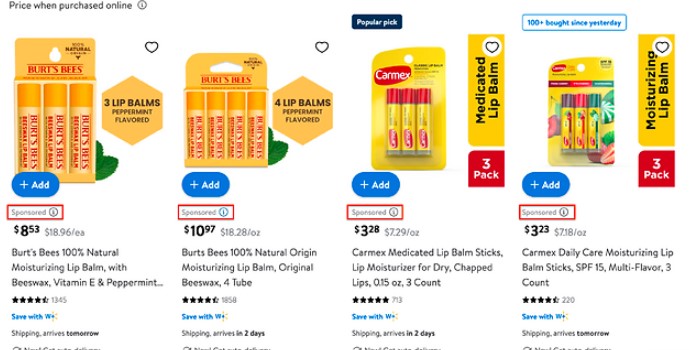
These ads can appear in any position within the search results, regardless of the organic ranking of the product.
Sellers can set both manual and automatic campaigns for these ads and control how much they spend by setting ad budgets and bids for each keyword.
It allows them to optimize their campaigns and achieve maximum ROI.
The minimum campaign spend for the Search In-Grid ad type is $100 for the total length of the campaign or a daily minimum of $50.
Eligibility Criteria:
- The product has to be in stoke
- Eligible to win buy box
- The ad should be relevant to the search term
- The product should belong to the same type as one or more top 20 organic results.
Walmart’s Search In-Grid ads are a great way to boost sales and organic rankings.
Walmart Sponsored Products – Carousel Ads
Walmart’s Product Carousel is another ad format for Walmart Sponsored Product ads.
These ads can appear in search, category, and product pages.
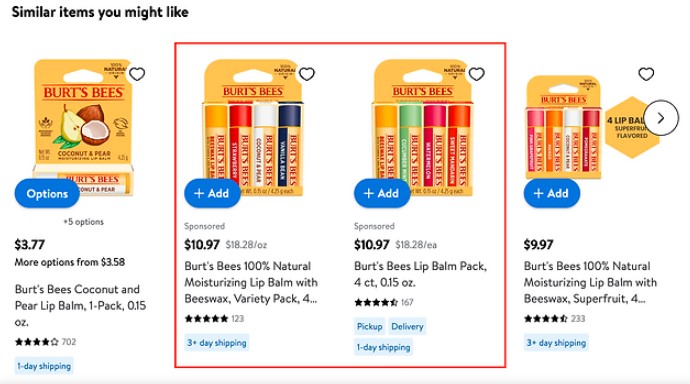
Unlike Search In-Grid ads, Carousel ads are not restricted by search terms. That means your carousel ads can reach new shoppers, increasing visibility and brand awareness.
Sellers can create both automatic and manual campaigns with Carousel ads.
In addition to organic results, Carousel ads let shoppers compare multiple products side-by-side, resulting in increased conversions.
Here are some of the places Walmart carousel ads can appear:
- Homepage (Featured items)
- Search results
- Category pages
- Browse pages
- Curated shelf pages
- Product detail pages (PDPs)
With these ad placements, sellers can create robust advertising strategies that increase their visibility and ultimately drive sales.
Walmart Sponsored Products – Buy Box Banner
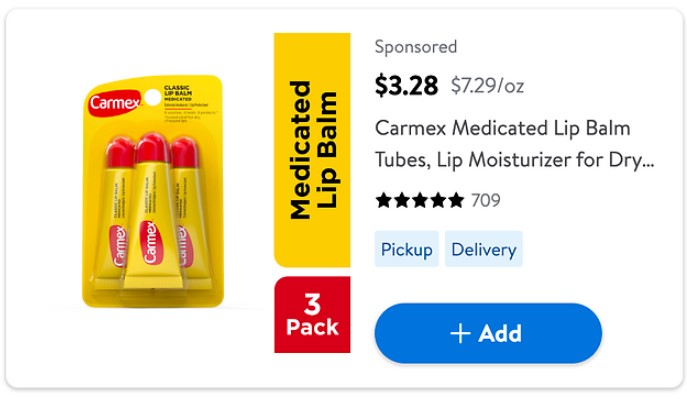
The Buy Box is a prime digital real estate space that appears on the product detail page.
Whenever a customer searches for a product, Walmart displays the Buy Box on the product detail page, with a direct CTA to add the product to the cart, making it a critical component of any seller’s strategy.
To win the Buy Box, sellers must meet specific criteria such as lower pricing, high seller ratings, reliable shipping, and customer service.
However, Walmart allows advertisers to bid on the Sponsored Buy Box Banner placement just below the organic Buy Box to show low-priced alternatives or complementary products.
Since these ads usually appear at the end of the shopping journey, their conversion rate is relatively high.
Walmart Sponsored Brand Ads

Walmart also offers a premium advertising feature called Sponsored Brands. It is designed to give your brand and products maximum visibility on search pages.
It includes the brand logo, a custom headline, and up to four product listings with clickable links.
Since Walmart Sponsored Brand ads appear at the top of the search results, giving your brand and products high visibility.
Benefits of Walmart Brand Ads:
Walmart’s Sponsored Brands feature offers several benefits to brands. Such as
- Brand Awareness: Sponsored Brands place your brand at the top of relevant search results, making it ideal for brands seeking exposure.
- Brand/Product Consideration: Sponsored Brands can make your products the first choice for customers in the consideration phase, making it perfect for those looking to engage customers.
- Sales and Conversion: With high viewability, Sponsored Brands can capture more sales, contributing to improved conversion rates and return on ad spend (ROAS).
Eligibility Criteria
To access Walmart Connect’s Sponsored Brands feature, Marketplace sellers must be brand owners and meet the following criteria:
- Sellers should be based in the United States, China, Hong Kong, or the United Kingdom, or a pre-approved seller in India.
- The brand rights owner should be registered with the United States Patent and Trademark Office.
- They should be onboarded to the Walmart Brand Portal, Walmart’s intellectual property rights management platform.
Walmart Sponsored Video Ads

Walmart Sponsored Video Ads are premium ad spaces that aim to improve the visibility of your product listings within search results.
These short, keyword-targeted video ads are designed to complement Walmart’s On-site Display ads and Brand ads by educating shoppers about the features and benefits of your products.
These ads usually span the entire width of the page on desktop, mobile, and app, playing automatically for a selected highlighted item.
The Autoplay begins when 50% of the video is in view and pauses when 50% is out of view. Clicking on the video usually redirects you to the product listing.
Benefits of Walmart Video Ads:
- These ads are highly engaging with visual storytelling to showcase product use cases and benefits.
- Sponsored Video ads complement product discoverability and brand awareness alongside Sponsored Products and Brand ads.
- These also help you to present your unique brand positioning in a descriptive and easy-to-understand narrative.
Eligibility:
- Must be registered as a brand owner through the Walmart Brand Portal.
- Must be registered brand owners using Item360.
- Only registered brand owners will have their accounts enabled for Sponsored Videos.
Walmart On-Site Sponsored Display Ads
Walmart offers various on-site display advertising ad options to sellers, each designed to capture the attention of potential customers. Here are some of them:
Brand Box:
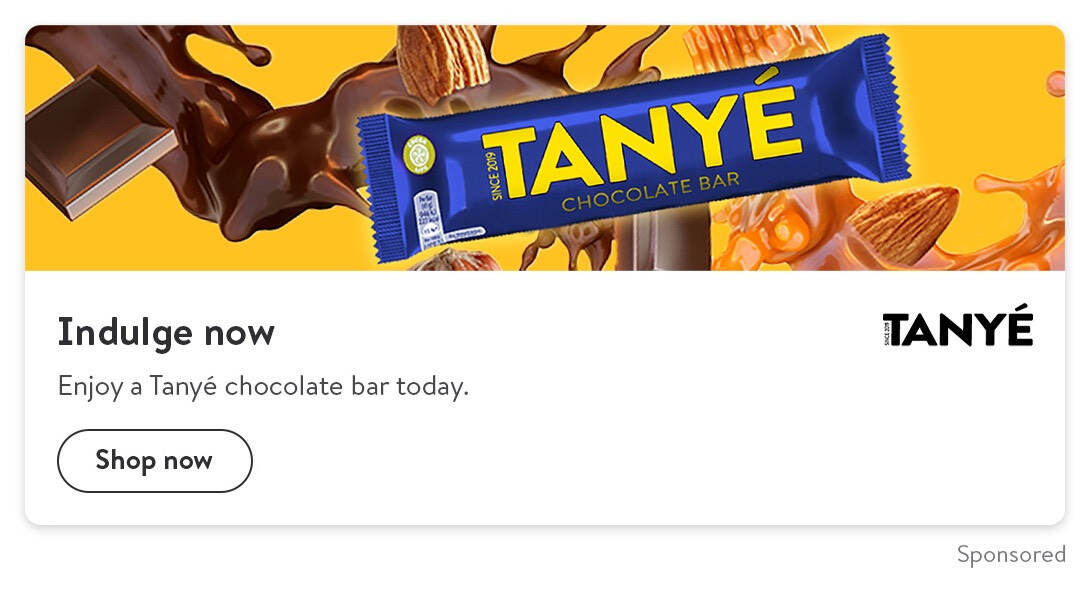
Source: Walmart
Positioned below the Buy Box on item pages, the Brand Box is a sticky desktop display that ensures high visibility throughout the user’s scroll. This feature enhances viewability and engagement, collapsing only at the end of customer reviews.
Gallery:
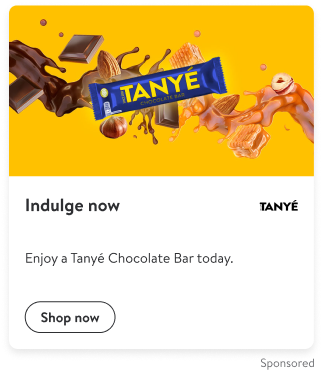
Source: Walmart
The Gallery comprises two or three horizontal units depending on the device size. Each card in the Gallery showcases a hero image, logo, headline, sub-headline, and a compelling “Shop now” call-to-action.
Marquee | Unified Experience:

Source: Walmart
Marquee ads now offer a unified experience across the Homepage, Search and Browse pages, and Item pages for desktop and mobile web. In the app, they appear on the Homepage and Item pages.
Walmart offers these advertising options through the Display Self-Serve (DSS) platform.
DSS streamlines the entire advertising process, from planning and activation to management and optimization, all while delivering an omnichannel impact.
Benefits of Walmart DSS:
- Walmart’s DSS integrates automation IP and technology, significantly reducing the time and resources required to launch campaigns.
- Advertisers can leverage Walmart’s behavioral, contextual, and keyword targeting to reach the most relevant shoppers. Custom audience targeting is also available.
- The Creative Builder and Creative Library in DSS allows advertisers easy and efficient creative control through automated templates.
- DSS breaks barriers with no budget minimums, providing access to Walmart’s first-party audiences and granting complete management control to advertisers.
Prior to the release of DSS, Walmart Connect exclusively managed onsite Display ad opportunities.
A lot of smaller and mid-size brands and sellers couldn’t participate in these display campaigns because of the high minimum ad spend.
On the other hand, DDS made on-site display advertising more accessible to smaller brands. Not just that, DDS also empowered large brands with on-demand control over their onsite ad efforts.
Walmart Display Auctions
DSS campaigns usually operate on a guaranteed placement model. However, Walmart has introduced a new Display auction to expand new display advertising options for sellers.
These auctions allow advertisers to bid on unreserved ad inventory, providing cost-effective opportunities.
Targeting Options for Display Auctions:
- Behavioral targeting (This includes brand, category, in-market, lapsed buyers, and propensity)
- Contextual targeting
- Persona targeting
- Custom audience targeting
- Keyword targeting (broad or exact match, negative keywords allowed)
- Run of site (Ads can appear and rotate on any site page except the home page)
- Geotargeting
Key Benefits of Display Auctions:
Display Auction has multiple benefits for sellers. Such as:
Bidding and Reporting:
Display Auctions lets you advertise on Walmart with flexible budgets and bids. You can see how your ads are performing in real time and adjust the budget as needed. You can also set a start and end date for your campaign and let Walmart optimize your spending.
No Minimum Spend:
Display Auctions have no minimum spend, making it accessible for advertisers of all sizes. However, reporting access requires approximately 1,000 daily impressions.
Apart from that, Walmart also offers a Demand-Side Platform (DSP) that allows advertisers to use Walmart’s first-party omnichannel data to reach customers across different channels and devices.
It provides closed-loop reporting that shows the impact of the ad campaigns on both online and offline sales.
How Much Does Walmart Spend on Advertising?
Walmart spent $3.9 billion on advertisements in FY2022, up 21.8% from $3.2 billion in FY2021.
The advertising expenses include digital, television, and print advertisements.
Walmart also uses social media, online advertising, and email to connect with customers and improve their shopping experience.
In FY2022, newspaper ads, internet ads, and media transmission made up most of the advertising costs.
Apart from that, Walmart frequently runs special offers throughout the year to attract their customers.
Difference Between Walmart and Amazon Advertising
Since we all know that advertising is the lever that pulls most revenue for sellers on Walmart, or Amazon, it’s essential to understand how these two ad platforms differ.
Amazon Has Massive Visibility Compared to Walmart
Amazon gets more than five times the number of visitors as Walmart in a month, which means more opportunities for brand recognition, but also comes with more competition for sellers.
Walmart Doesn’t Have an In-house Brand
While Amazon does give third-party sellers a platform to sell on, they also compete directly with these sellers with their own products, sometimes rebranding generic items.
On the other hand, Walmart doesn’t sell products under its own brand, making it a good platform for 3P brands to sidestep the fierce competition and capitalize on the demand of Walmart.
Walmart Has Limited Targeting Options
Amazon and Walmart work with different strategies when it comes to keyword targeting and ad spending.
While Amazon allows sellers to use keyword, product, and category targeting, Walmart only offers keyword targeting to sellers.
These differences can impact the success of advertising different types of sellers in each market.
Success on Amazon depends on maintaining a presence in an attributes-driven market where shoppers search for specific types of products regardless of brand. In fact, studies show that 78% of Amazon searches are unbranded.
In contrast, Walmart sellers rely more on brand exclusivity to win bids for popular keyword targets.
Due to this, lesser-known brands may find it more difficult to compete with larger, more established companies at Walmart.
Amazon Lacks Transparency
Amazon hasn’t exactly earned a reputation for offering transparent seller analytics, especially for customer behavior data.
This lack of transparency makes it challenging to get crucial information about your shoppers and impacts your ability to create data-driven advertising strategies.
On the contrary, Walmart’s approach is more transparent, giving sellers better access to shoppers’ data.
Final Thoughts
Walmart advertising is a powerful option for sellers to reach millions of shoppers and boost their sales.
Whether you’re new to Walmart or an experienced seller, by using the different ad types strategically, you can create profitable ad campaigns and maximize your RoAS effectively.
Meanwhile, if you need any help with Walmart or Amazon advertising, you can connect with SellerApp PPC experts.
We’ve helped some of the world’s biggest brands, like Phillips and Coca-Cola, to achieve incredible results with data-driven advertising strategies.
And we can do the same for you!
Schedule a call with us, and let’s work together to grow your brand and reach your goals faster!
Additional read:
Amazon Advertising Audit Checklist
Eligibility Criteria for Walmart Restored Program
Surprising Walmart Facts and Statistics That Will Blow Your Mind
Walmart Private Label Brands: Top-selling Brands Across Different Categories








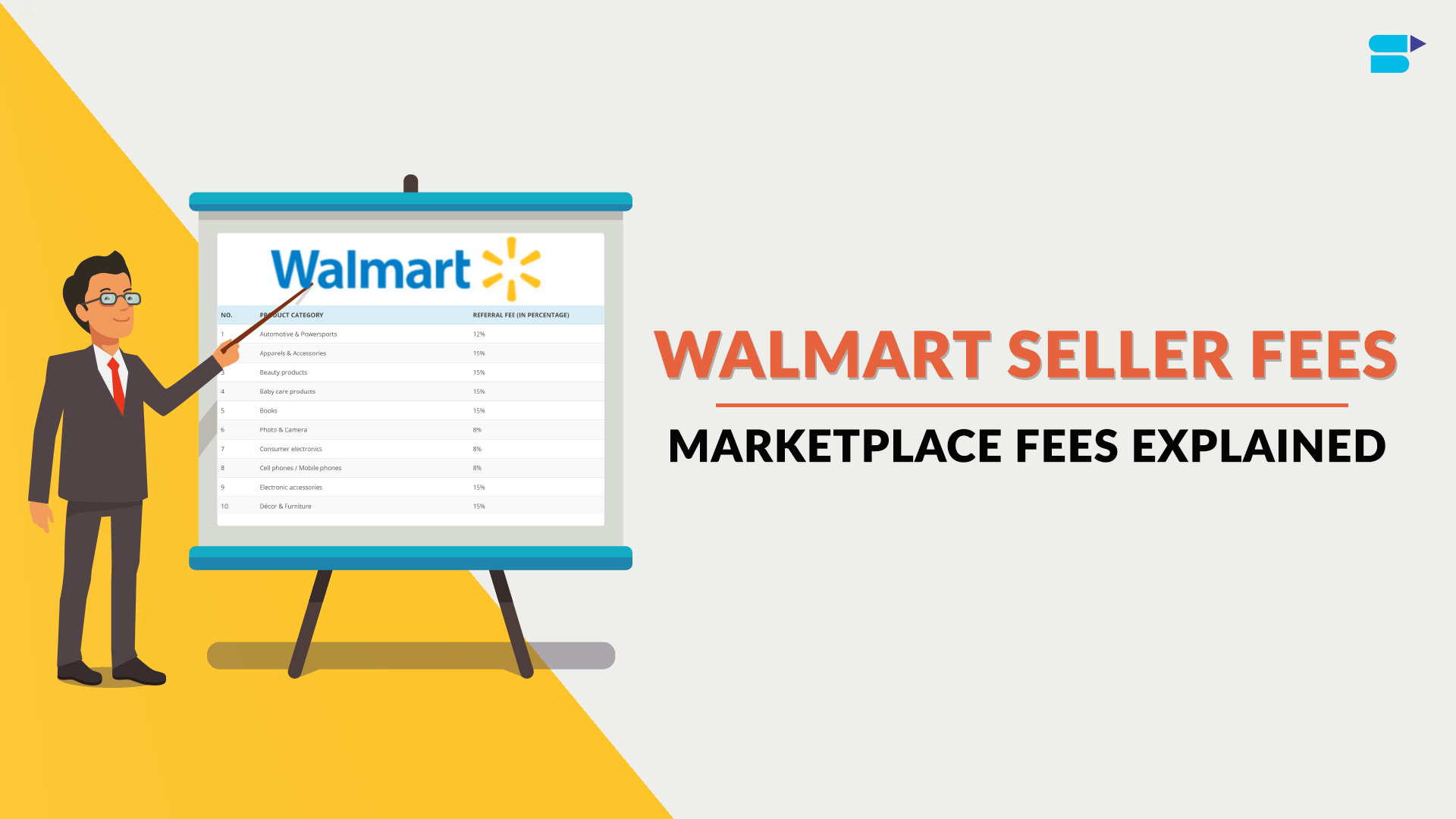


Frank Edwayds
November 1, 2023Great overview of Walmart ads! The post simplified the different types, making it easy for me to choose the right one for my business. Practical and valuable information, much appreciated
Clare Thomas
March 7, 2024Thank you for your feedback.
Larry Barnes
November 21, 2023Insightful breakdown of Walmart ads types! Loved how the post clarified the distinctions, making it easier to navigate advertising options. Very helpful – thanks for simplifying a complex subject!
Clare Thomas
March 7, 2024Very happy to hear that.